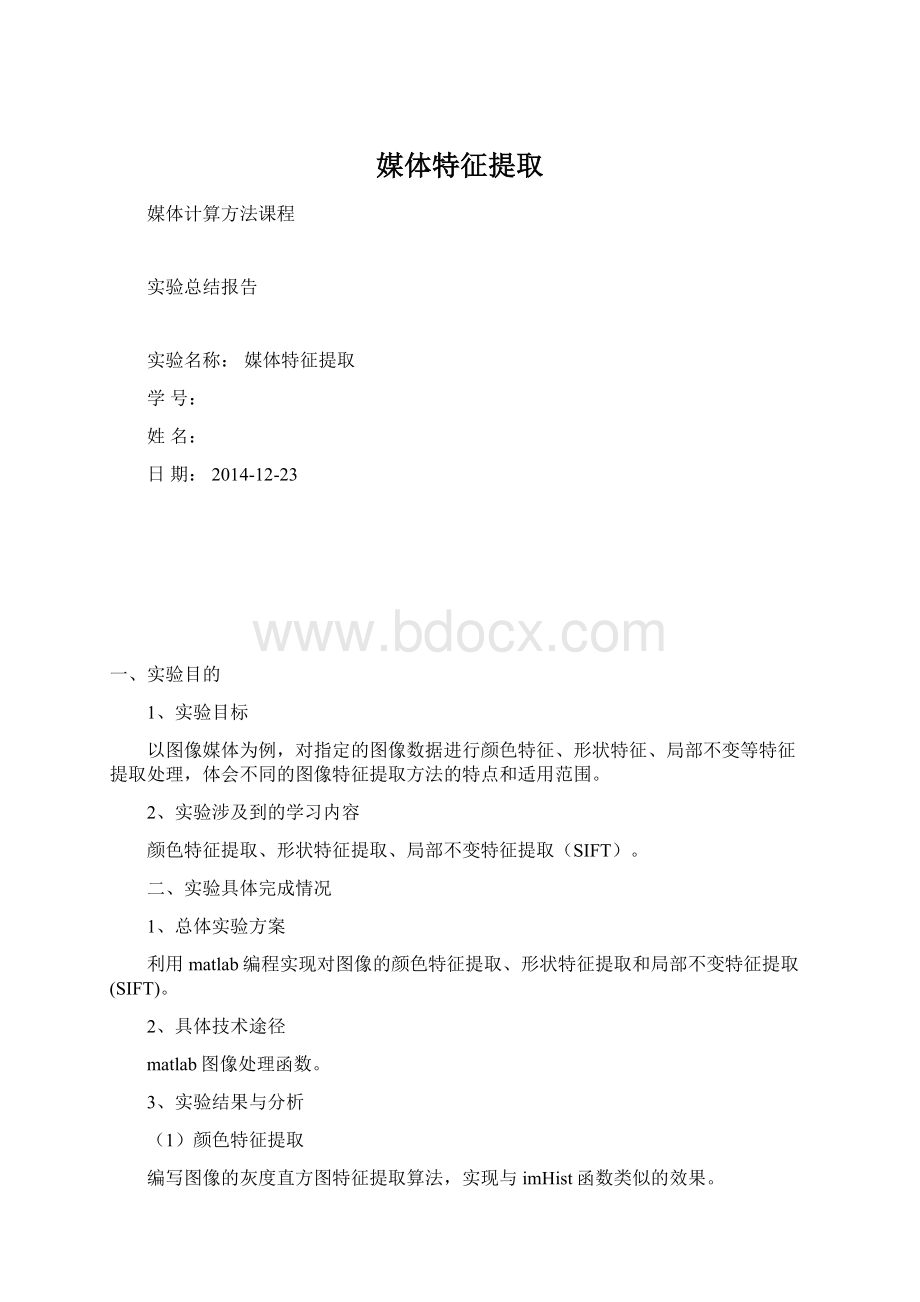媒体特征提取.docx
《媒体特征提取.docx》由会员分享,可在线阅读,更多相关《媒体特征提取.docx(13页珍藏版)》请在冰豆网上搜索。

媒体特征提取
媒体计算方法课程
实验总结报告
实验名称:
媒体特征提取
学号:
姓名:
日期:
2014-12-23
一、实验目的
1、实验目标
以图像媒体为例,对指定的图像数据进行颜色特征、形状特征、局部不变等特征提取处理,体会不同的图像特征提取方法的特点和适用范围。
2、实验涉及到的学习内容
颜色特征提取、形状特征提取、局部不变特征提取(SIFT)。
二、实验具体完成情况
1、总体实验方案
利用matlab编程实现对图像的颜色特征提取、形状特征提取和局部不变特征提取(SIFT)。
2、具体技术途径
matlab图像处理函数。
3、实验结果与分析
(1)颜色特征提取
编写图像的灰度直方图特征提取算法,实现与imHist函数类似的效果。
算法思想:
利用for循环对原始图像进行遍历,统计每个颜色值在图像中的像素个数,根据统计结果绘制直方图。
实验结果
图1本算法绘制的原始图像的直方图
图2imhist函数绘制的原始图像直方图
(2)形状特征提取
通过边缘检测等方法提取简单图像的边界特征,并用链码的方式保存图像的形状特征。
算法思想:
对原始图像进行边缘提取,在得到的边缘特征矩阵中寻找一个非零点,即边缘像素点,从该点开始,沿顺时针方向遍历其相邻8个像素点,记录第一个非零点的相对位置。
再遍历这个边缘像素点周围的像素点,寻找下一个边缘像素点,直到重新遍历到初始点停止。
实验结果
图3原始图像
图4提取的图像边缘特征
算法只提取了图像的边缘特征,并直接调用matlab的fchcode函数对图像边缘特征链码表示。
(3)局部不变特征提取
对于选定的某幅图像,提取SIFT局部不变特征,体会该特征的旋转、尺度、光照等不变性。
算法思想:
构建原始图像高斯金字塔;再同尺度相邻相差构建差分高斯金字塔;寻找尺度空间极值点,并删除错误点,其余为关键点;计算关键点坐标和所处的尺度;以关键点邻域梯度的主方向作为该点的方向特征。
这里是使用别人写好的SIFT特征提取类函数,自己对其进行调用来实现特征提取以及匹配。
实验结果
图5原始图像
图6提取的原始图像的SIFT特征信息
图7相似图像的SIFT特征匹配
三、存在的主要问题和建议
三个小的实验算法思想并不难,但是在实现过程中发现自己的编程水平还有欠缺,理解了算法的思想,但是由于技术所限不能够按照算法思想自己编写一套程序。
只能调用别人写好的函数实现自己预想的功能。
另外此次实验都是在matlab中实现的,但在以后的工程实践中可能更多的是使用opencv,所以接下来要学习一下opencv的使用,现已在自己电脑的vs2010上配置好了opencv2.4.2,自己会在学习使用opencv的过程中重新实现以上实验。
附:
程序核心源代码
(1)颜色特征提取
closeall
%imhist直方图特征提取
f1=imread('Fig1202(c)(WashingtonDC_Band3_512).tif');
subplot(1,2,1),imshow(f1),title('WashingtonDC_Band');
subplot(1,2,2),imhist(f1),title('imhist');
%自己编写imhist提取函数
[m,n]=size(f1);
a=zeros(1,256);
fori=1:
m
forj=1:
n
a(f1(i,j)+1)=a(f1(i,j)+1)+1;
end
end
figure();
subplot(1,2,1),imshow(f1),title('WashingtonDC_Band');
subplot(1,2,2),bar(a,'b');
axis([02550max(a)+1000]),title('myself--imhist');
(2)形状特征提取
f=imread('Fig1107(a)(mapleleaf).tif');
g=edge(f,'sobel');
B=boundaries(g);
b=B{1,1};
c=fchcode(b);
(3)尺度不变特征提取(Demo见附件)
%sift.m
%[image,descriptors,locs]=sift(imageFile)
%
%ThisfunctionreadsanimageandreturnsitsSIFTkeypoints.
%Inputparameters:
%imageFile:
thefilenamefortheimage.
%
%Returned:
%image:
theimagearrayindoubleformat
%descriptors:
aK-by-128matrix,whereeachrowgivesaninvariant
%descriptorforoneoftheKkeypoints.Thedescriptorisavector
%of128valuesnormalizedtounitlength.
%locs:
K-by-4matrix,inwhicheachrowhasthe4valuesfora
%keypointlocation(row,column,scale,orientation).The
%orientationisintherange[-PI,PI]radians.
%
%Credits:
ThanksforinitialversionofthisprogramtoD.Alvaroand
%J.J.Guerrero,UniversidaddeZaragoza(modifiedbyD.Lowe)
function[image,descriptors,locs]=sift(imageFile)
%Loadimage
image=imread(imageFile);
%IfyouhavetheImageProcessingToolbox,youcanuncommentthefollowing
%linestoallowinputofcolorimages,whichwillbeconvertedtograyscale.
%ifisrgb(image)
%image=rgb2gray(image);
%end
[rows,cols]=size(image);
%ConvertintoPGMimagefile,readableby"keypoints"executable
f=fopen('tmp.pgm','w');
iff==-1
error('Couldnotcreatefiletmp.pgm.');
end
fprintf(f,'P5\n%d\n%d\n255\n',cols,rows);
fwrite(f,image','uint8');
fclose(f);
%Callkeypointsexecutable
ifisunix
command='!
./sift';
else
command='!
siftWin32';
end
command=[command'tmp.key'];
eval(command);
%Opentmp.keyandcheckitsheader
g=fopen('tmp.key','r');
ifg==-1
error('Couldnotopenfiletmp.key.');
end
[header,count]=fscanf(g,'%d%d',[12]);
ifcount~=2
error('Invalidkeypointfilebeginning.');
end
num=header
(1);
len=header
(2);
iflen~=128
error('Keypointdescriptorlengthinvalid(shouldbe128).');
end
%Createsthetwooutputmatrices(useknownsizeforefficiency)
locs=double(zeros(num,4));
descriptors=double(zeros(num,128));
%Parsetmp.key
fori=1:
num
[vector,count]=fscanf(g,'%f%f%f%f',[14]);%rowcolscaleori
ifcount~=4
error('Invalidkeypointfileformat');
end
locs(i,:
)=vector(1,:
);
[descrip,count]=fscanf(g,'%d',[1len]);
if(count~=128)
error('Invalidkeypointfilevalue.');
end
%Normalizeeachinputvectortounitlength
descrip=descrip/sqrt(sum(descrip.^2));
descriptors(i,:
)=descrip(1,:
);
end
fclose(g);
%showkeys.m
%showkeys(image,locs)
%
%ThisfunctiondisplaysanimagewithSIFTkeypointsoverlayed.
%Inputparameters:
%image:
thefilenamefortheimage(grayscale)
%locs:
matrixinwhicheachrowgivesakeypointlocation(row,
%column,scale,orientation)
functionshowkeys(image,locs)
disp('DrawingSIFTkeypoints...');
%Drawimagewithkeypoints
figure('Position',[5050size(image,2)size(image,1)]);
colormap('gray');
imagesc(image);
holdon;
imsize=size(image);
fori=1:
size(locs,1)
%Drawanarrow,eachlinetransformedaccordingtokeypointparameters.
TransformLine(imsize,locs(i,:
),0.0,0.0,1.0,0.0);
TransformLine(imsize,locs(i,:
),0.85,0.1,1.0,0.0);
TransformLine(imsize,locs(i,:
),0.85,-0.1,1.0,0.0);
end
holdoff;
%------Subroutine:
TransformLine-------
%Drawthegivenlineintheimage,butfirsttranslate,rotate,and
%scaleaccordingtothekeypointparameters.
%
%Parameters:
%Arrays:
%imsize=[rowscolumns]ofimage
%keypoint=[subpixel_rowsubpixel_columnscaleorientation]
%
%Scalars:
%x1,y1;beginingofvector
%x2,y2;endingofvector
functionTransformLine(imsize,keypoint,x1,y1,x2,y2)
%Thescalingoftheunitlengtharrowissettoapproximatelytheradius
%oftheregionusedtocomputethekeypointdescriptor.
len=6*keypoint(3);
%Rotatethekeypointsby'ori'=keypoint(4)
s=sin(keypoint(4));
c=cos(keypoint(4));
%Applytransform
r1=keypoint
(1)-len*(c*y1+s*x1);
c1=keypoint
(2)+len*(-s*y1+c*x1);
r2=keypoint
(1)-len*(c*y2+s*x2);
c2=keypoint
(2)+len*(-s*y2+c*x2);
line([c1c2],[r1r2],'Color','c');
%match.m
%num=match(image1,image2)
%
%Thisfunctionreadstwoimages,findstheirSIFTfeatures,and
%displayslinesconnectingthematchedkeypoints.Amatchisaccepted
%onlyifitsdistanceislessthandistRatiotimesthedistancetothe
%secondclosestmatch.
%Itreturnsthenumberofmatchesdisplayed.
%
%Example:
match('scene.pgm','book.pgm');
functionnum=match(image1,image2)
%FindSIFTkeypointsforeachimage
[im1,des1,loc1]=sift(image1);
[im2,des2,loc2]=sift(image2);
%ForefficiencyinMatlab,itischeapertocomputedotproductsbetween
%unitvectorsratherthanEuclideandistances.Notethattheratioof
%angles(acosofdotproductsofunitvectors)isacloseapproximation
%totheratioofEuclideandistancesforsmallangles.
%
%distRatio:
Onlykeepmatchesinwhichtheratioofvectoranglesfromthe
%nearesttosecondnearestneighborislessthandistRatio.
distRatio=0.6;
%Foreachdescriptorinthefirstimage,selectitsmatchtosecondimage.
des2t=des2';%Precomputematrixtranspose
fori=1:
size(des1,1)
dotprods=des1(i,:
)*des2t;%Computesvectorofdotproducts
[vals,indx]=sort(acos(dotprods));%Takeinversecosineandsortresults
%CheckifnearestneighborhasanglelessthandistRatiotimes2nd.
if(vals
(1)(2))
match(i)=indx
(1);
else
match(i)=0;
end
end
%Createanewimageshowingthetwoimagessidebyside.
im3=appendimages(im1,im2);
%Showafigurewithlinesjoiningtheacceptedmatches.
figure('Position',[100100size(im3,2)size(im3,1)]);
colormap('gray');
imagesc(im3);
holdon;
cols1=size(im1,2);
fori=1:
size(des1,1)
if(match(i)>0)
line([loc1(i,2)loc2(match(i),2)+cols1],...
[loc1(i,1)loc2(match(i),1)],'Color','c');
end
end
holdoff;
num=sum(match>0);
fprintf('Found%dmatches.\n',num);
%appendimages.m
%im=appendimages(image1,image2)
%
%Returnanewimagethatappendsthetwoimagesside-by-side.
functionim=appendimages(image1,image2)
%Selecttheimagewiththefewestrowsandfillinenoughemptyrows
%tomakeitthesameheightastheotherimage.
rows1=size(image1,1);
rows2=size(image2,1);
if(rows1image1(rows2,1)=0;
else
image2(rows1,1)=0;
end
%Nowappendbothimagesside-by-side.
im=[image1image2];